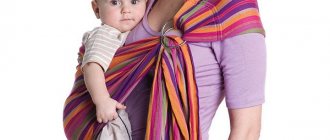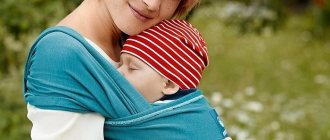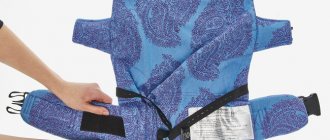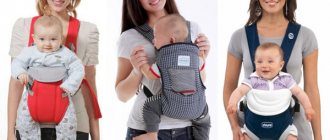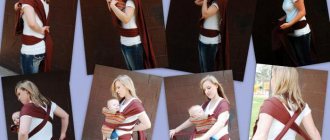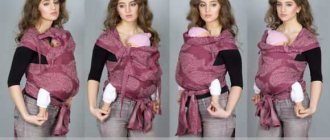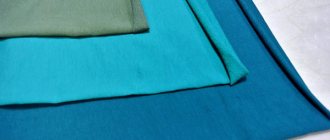The sling came to us from Asian countries, where traditionally the child was always with the mother. All the work was done by a woman with a child at her heart. Slings appeared many thousands of years ago. Archaeologists have found ancient frescoes that depicted women carrying children with the help of fabric wrapped several times around themselves.
Currently, a sling is a wonderful device that allows a mother to be mobile and, at the same time, not be separated from her baby for a minute. It can even be used to carry newborn babies.
Sling with rings for newborns
Ring sling is the best option
The very name of the device translates as “sling,” and is a fairly ancient way of carrying a child on oneself. In our country, slings have only recently become popular, and more and more mothers are giving preference to the model with rings as the most comfortable. It is a strip of fabric 2 m long, where one end is pulled through rings for fixation and twisted freely.
There are other models of slings - just a scarf and its analogue, the May-sling, as well as a sling-backpack. All of them create comfort for the baby, but mothers prefer to carry the child in a sling with rings.
You can use this model from the first days of a baby’s birth until 2 years of age. For most young families, a sling has even replaced a stroller, as it does not require special storage space.
The baby, securely fixed to the mother, nevertheless feels comfortable - he can freely change his position. And the mother will not have to remove the sling to move the baby. In addition, there are other advantages that make it possible to choose a sling with rings.
How to choose the right one
Material
Despite the simplicity of the design, such a carrier should be as safe as possible for the child. This is only possible when choosing a high-quality and correct sling with rings. The main thing is that the material from which the sling is made must be 100% natural (cotton, wool, linen), because it is used for a newborn. Ideal for such carrying is double diagonal fabric, that is, scarf or jacquard types of thread weaving, which does not stretch either along the length or width, but has a good displacement of the threads diagonally.
Rings
The rings should be 6–8 cm in diameter, solid cast, without solders or gaps, preferably made of aluminum alloy. It is also possible to use wooden rings; they are not as slippery as metal ones and have hypoallergenic properties, but are less durable and can break. Plastic or nylon rings are a more budget-friendly option; they are lightweight and can be given any color, but such rings are often not dense and are easily deformed and crack under load. Therefore, their use is advisable only if there is confidence in the manufacturing company.
Dimensions
Standard ring slings are in most cases approximately 200 cm long and 70 cm wide, but there are other options. Many manufacturers offer slings in several sizes; this is true for slings that have soft sides at the edges. They are selected according to the size of the adult who will wear the carrier. Russian size 42-44 corresponds to size S, the length of such a carrier is 175 - 185 cm; sizes 46, 48, 50 fit size M, its length is 185–195 cm; owners of clothing sizes 52 and 54 need a sling L with a length of 190–200 cm; and, finally, those who are 56 and older should choose an XL size carrier, the length of which is in the range of 200–210 cm.
Additional accessories
As for additional devices to make the carrier easier to use, not all of them are as necessary as the manufacturer is trying to convince us. When purchasing a carrier, you can find models with a pad designed to relieve the pressure of the rings on the shoulder. However, it rests on a rather narrow part of the shoulder, so the effect of such a device is minimal. A pad made of thin material will not bring any benefit at all. In a proper sling, there should be no pressure on the shoulder due to the diagonal weaving of the thread and a wide strap that completely covers the shoulder. Due to this feature, the weight is correctly distributed and the load on the spine is reduced. The next “bonus” is the presence of sides - this is a lining made of dense material located along the edges of the carrier. If you purchase such a model, you should remember that the edges of the sides should not reach the rings by about 5 - 10 cm when the child is in the carrier. Otherwise, the side will get under the rings and thereby make it difficult to tighten correctly; the baby may not be pulled enough towards the mother. If we judge the practical benefits of such a “revision”, then, in fact, there is none, because the sling with rings is designed in such a way that the support of the child is achieved due to the tension of the fabric, and the presence or absence of sides has nothing to do with this.
shoulder pad
sling with sides
There are options on sale with detachable rings (supposedly convenient for washing), with a sewn-in tail, double layers of fabric and many other “additives”, but they do no more good than harm.
It is best for both the baby and the mother to opt for a classic model of such a carrier, with such pleasant little things as a pocket on the tail for small necessary things. The pocket can be replaced with interesting applications or straps on which you can hang a toy for your baby.
Why is a ring sling better?
This model is very comfortable for both mother and child
The main point why mothers fell in love with this model is that it is very easy to put on and just as easy to take off. The child takes the position in it that he likes most.
- When the baby is lying down in the sling, he takes a comfortable horizontal position, as if he were being held in his arms. In this case, the baby's head is on the same plane with the back, which ensures comfort. And the mother can constantly see the little one’s face.
- When sitting in front of the mother, the child’s knees are at a level above the butt, which is not observed in the “kangaroo”. This allows the baby to take a more symmetrical position.
- A sling with rings is better than a pseudo-sling bag, as it allows the child to breathe normally, because the chin is not pressed against the chest.
- It is very convenient to feed a baby in a sling on the street - the baby’s position is comfortable, and a scarf will hide this process from prying eyes.
If you wear a sling with rings, as the instructions recommend, the baby will be quite well fixed on the mother’s body. This creates convenience for her movement.
For lying position
- Put on the sling basicly (indicated above),
- Spread the fabric over the back and in the rings and tuck the outer edge inside.
- The baby is on the shoulder where there are no rings, we thread his legs under the sling and straighten the fabric over the baby’s entire body (from head to knees)
- We lean forward slightly in order to place the baby: the body is tummy to your stomach, the handle is under your armpit, the head is diagonal to the rings
- The side of the sling covers only half of the baby's head, distribute the rest of the fabric over the entire body
- Pull the tail of the sling near the rings literally one centimeter at a time (until you get the hang of it) so that the baby’s head is near your chest, and the legs are slightly lower; the butt should be in the lowest position.
- Move the pillow near your neck almost to your shoulder so that it does not rub.
How to wear a ring sling
There are several options for carrying a child in this device. The mother not only chooses what is more comfortable for her - she can periodically change the position of the baby without unfastening the sling. Recommendations on how to carry a baby in a sling are given below.
- For newborns in the first months of life, the “cradle” position is chosen, when the baby is placed horizontally under the mother’s breast.
- Mothers love to carry babies who have reached 4 months of age in front of them, fixing them in a sitting position on their stomach. This makes it easier for her to monitor the baby’s condition.
- Slightly older children can be placed on their back. This will make it more convenient for mom to carry her purchases in her hands.
- There is also the “on the thigh” position, but not all women practice it. Although it is also convenient.
There are different ways to carry a baby in a sling
Any of the positions should be changed periodically so that the baby’s muscle corset develops evenly. And my mother’s posture will suffer less this way. The main thing is to learn how to put on the structure correctly.
How to wear a ring sling
Before placing the baby in this convenient device, the mother must put it on herself. At the same time, she should clearly know how to tie a sling with rings. The baby’s safety will depend on this.
How to tie a ring sling
- To begin with, mom carefully examines the fabric panel, at one end of which rings are sewn. They can be metal, wood or plastic. The second end is called the "tail" and will be passed through these rings.
- Having straightened the canvas, they take the “tail” in one hand and hold the rings in the other. In this case, the scarf should not be twisted.
- The “tail” is pulled through both rings at once, stretching the fabric approximately 0.7 m.
- Then the “tail” is folded back and pulled again through one ring, straightening the fabric evenly.
- Holding the rings in the right hand, the left hand is threaded into the sling.
- Next, the sling is thrown over the head, placing it on the right shoulder. In this case, the rings are located at the level of the collarbone, and the “tail” hangs forward.
The instructions given on how to tie a ring sling are standard for all positions. If the mother masters it correctly, then it will not be difficult for her to place the toddler in such a device.
How to carry a baby in a ring sling correctly
In order for the baby to feel comfortable in a scarf, the mother needs to take into account some recommendations.
- Firstly, the fabric from which the sling is made should not stretch, otherwise it will deform very quickly.
- When putting on the device, the mother must carefully ensure that the fabric does not twist or turn inside out. The canvas should be well straightened. Otherwise, the baby will experience discomfort, from which he will get tired very quickly.
- If the sling is put on loosely, the baby will sag in it, taking the wrong position. This will affect the development of his musculoskeletal system. You can ensure the required tension using the “tail”.
- When placing the baby in a sling, you need to make sure that his face is not covered by either the mother’s clothes or the fabric of the scarf, otherwise the baby may suffocate.
How comfortable it is for her and the baby will depend only on the mother’s care and attention.
Ring sling - how to best carry a newborn
It is especially important to carefully carry a baby in the first 3 months of his life, when every bone or cartilage is quite fragile. The best option here to use a sling is the “cradle” position.
- Having put on the sling as described above, the woman forms a cozy “hammock” from it under her breasts.
- Taking the baby under the back with your left hand, hold the edge of the canvas with your right. In the pocket, the baby is placed on his side so that the sling holds his butt well.
- Then the edge of the canvas is straightened, pulling it over the back and up to the head. It will be more convenient to do this if the mother leans forward a little.
- To give the baby the desired position, the inner edge of the pocket needs to be pulled up. In this case, the baby is positioned across the canvas in such a way that his legs are near the rings, and his head is under the mother’s breast on the opposite side. In newborns, the legs should be completely in the sling; in infants older than 2 months, they should hang slightly outward.
- Now they tighten the “tail” of the scarf, adjusting the child’s position. In this case, the baby’s head should neither tilt back nor bend towards the chest.
Before placing your baby in a comfortable structure, learn how to wear a sling with rings, preferably on a doll. Having practiced in this way, the mother can safely go for a walk with the baby.
Sling selection criteria
Diapers for newborns from 0 to 3 months
You shouldn't buy the first model you come across. You should carefully weigh the pros and cons, and consider several options. When choosing, the main role should be played by:
- Quality of material and availability of additional components;
- Convenience;
- Ease of operation;
- Availability of several baby carrying positions depending on age.
It is best to choose a simple, inexpensive model that is easy to care for.
Good material and components
The best option is thick knitwear that stretches well. Linen and cotton are also suitable. Rings are made of metal or plastic. The product must have well stitched seams.
The product must be made of high-quality and durable fabric, processed according to all the rules
Attention! If the material has a strong chemical smell, you should not purchase the product. It is probably made in China from low quality material. Staying in such a sling can cause allergic reactions in the baby.
Functionality
Sling scarves for newborns are comfortable and functional. The “for growth” option can easily be transformed. When the baby is just born, he is placed in a horizontal position, like in a cradle. An older child is placed in an upright position so that he can look around and feel comfortable while awake.
Convenience and ease of use
Slings for feeding newborns and walking are easy to use, the main thing is to carefully read the instructions. It is best to ask an experienced mother for help. She will show you how to wrap the fabric around yourself so as not to get tangled.
Sling care
Baby slings are easy to care for; just wash them when they get dirty. Do not use aggressive chemical detergents or stain removers during washing. Knitted models are not twisted when squeezing, so that they do not stretch.
Price
How to choose a sling for a newborn is often influenced by cost. You can find a quality product from 1000 rubles, but it is better to choose a sling costing 2-3 thousand. Cheap models of dubious appearance for babies will not last long.
